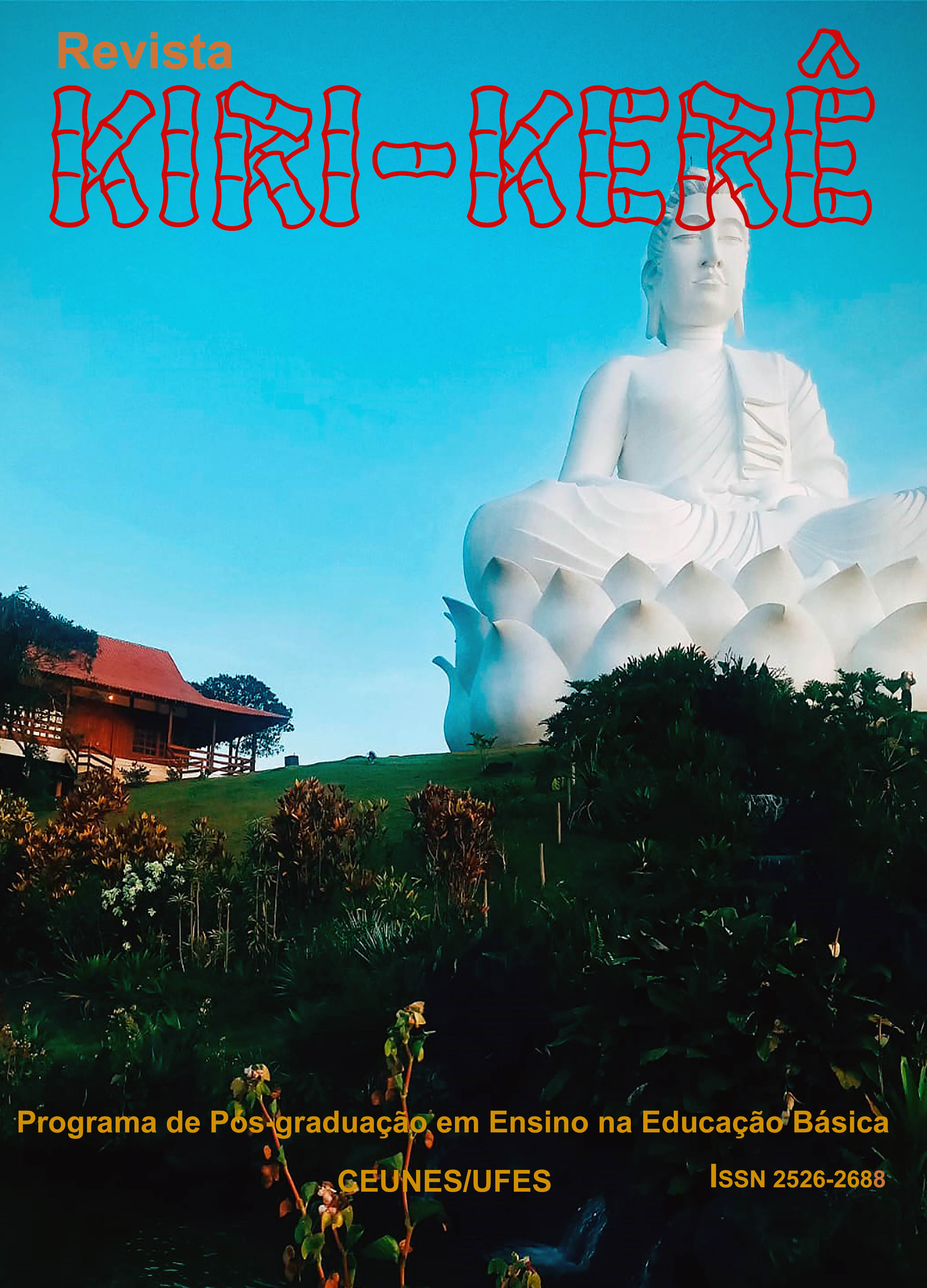Intervenções Pedagógicas sobre o cotidiano mediadas por tecnologia
um estudo de caso sobre ensino de Arte e Matemática durante a pandemia da COVID-19
DOI:
https://doi.org/10.47456/krkr.v1i16.35807Palavras-chave:
cotidiano; tecnologia; formação de professores; educaçãoResumo
Este estudo objetiva analisar duas intervenções construídas numa perspectiva de mediação para o ensino das disciplinas de Arte e Matemática, recorrendo aos instrumentos tecnológicos para o seu desenvolvimento e o tema do cotidiano. Trata-se de uma pesquisa qualitativa cujo desenvolvimento ocorreu por meio de um estudo de caso descritivo. Quanto aos processos escolhidos para o caminho metodológico, incluímos: entrevista aos professores que realizaram a intervenção pedagógica e os registros das atividades desenvolvidas pelos alunos. Ao final das análises concluímos que diante do cenário da Covid 19, o papel do professor modifica-se em propostas presenciais, online ou híbrida, sendo fundamental uma remodelagem de suas abordagens em cada cenário para uma melhor adaptação e aprendizagem do discente, além de considerarmos a relevância de práticas colaborativas e com abordagem do cotidiano dos alunos. Este estudo objetiva analisar duas intervenções construídas numa perspectiva de mediação para o ensino das disciplinas de Arte e Matemática, recorrendo aos instrumentos tecnológicos para o seu desenvolvimento e o tema do cotidiano. Trata-se de uma pesquisa qualitativa cujo desenvolvimento ocorreu por meio de um estudo de caso descritivo. Quanto aos processos escolhidos para o caminho metodológico, incluímos: entrevista aos professores que realizaram a intervenção pedagógica e os registros das atividades desenvolvidas pelos alunos. Ao final das análises concluímos que diante do cenário da Covid 19, o papel do professor modifica-se em propostas presenciais, online ou híbrida, sendo fundamental uma remodelagem de suas abordagens em cada cenário para uma melhor adaptação e aprendizagem do discente, além de considerarmos a relevância de práticas colaborativas e com abordagem do cotidiano dos alunos.
Downloads
Referências
ANDRÉ, Marli Eliza Dalmazo Afonso de. Estudo de caso em pesquisa e avaliação educacional. Brasília: Liber Livro Editora, 2005.
BARDIN, Laurence. Análise de conteúdo. Tradução de Luís Antero Reto e Augusto Pinheiro. 1ª ed. São Paulo: Edições 70, 2011.
BAUER, Martin William. Classical Content Analysis: A Review. In: BAUER, Martin William; GASKELL, George; Qualitative Researching with Text, Image and Sound: A Practical Handbook. Los Angeles, London, New Delhi, Singapore: SAGE, 2000, p.131-150.
BELMONTE, Vanessa. GROSSI, Márcia Gorett Ribeiro. Ambientes virtuais de aprendizagem. Um panorama da produção nacional. Disponível em <http://www.abed.org.br/congresso2010/cd/2942010181132.pdf>. Acesso em 11 de abr. de 2021.
BORBA, Marcelo Carvalho. CHIARI, Aparecida Santana de Souza, & Almeida, Helber Rangel Formiga Leite de. (2018). Interactions in virtual learning environments: New roles for digital technology. Educational Studies in Mathematics, 98, 269–286. Disponível em: <https://link.springer.com/article/10.1007/s10649-018-9812-9>, Acesse em: 02 de maio. 2021
BOURCIER, Paul. História da Dança no Ocidente. São Paulo: Martins Fontes, 2006.
BRASIL, MEC. Parâmetros Básicos de Infraestrutura para instituições de Educação Infantil/ Encarte 1. Brasília. MEC/SEB, 2006. Disponível em: <http://portal.mec.gov.br/seb/arquivos/pdf/Educinf/miolo_infraestr.pdf >. Acesso em: 11 abr. 2021.
BRITO. Glaucia da Silva; PURIFICAÇÃO, Ivonélia da. Educação e Novas Tecnologias: um repensar. São Paulo: Pearson, 2012.
FIORENTINI, Dario; LORENZATO, Sérgio. Investigação em educação matemática: percursos teóricos e metodológicos. 3ª. Campinas, SP: Autores Associados, 2009.
FREIRE, Paulo. Pedagogia do Oprimido. Rio de Janeiro: Paz e Terra, 1988.
GAUTHIER, Clermont. Por uma teoria da pedagogia: pesquisas sobre o saber docente. 3 ed. Ijuí: Ed. Unijuí, 2013.
ITAÚ CULTURAL. READY-MADE. ENCICLOPÉDIA Itaú Cultural de Arte e Cultura Brasileiras. São Paulo:, 2021. Disponível em: <http://enciclopedia.itaucultural.org.br/termo5370/ready-made>. Acesso em: 23 de abr. 2021.
MORAN, José Manuel. Desafios que a educação a distância traz para a presencial. UNOPAR CIENTÍFICA CIÊNCIAS HUMANAS E DA EDUCAÇÃO, Londrina, v. 5, n. 1, p. 27-33, jun. 2004. Disponível em: <https://revista.pgsskroton.com/index.php/ensino/article/view/1115> . Acesso em: 25 abr. 2021.
MOREIRA, Marco Antonio. O que é afinal aprendizagem significativa? Qurriculum, La Laguna, Espanha, p. 1-27, 2012. Disponível em: <http://moreira.if.ufrgs.br/oqueeafinal.pdf>. Acesso em: 10 abr. 2021.
MOREIRA, Tamya de Oliveira Ramos. A música na Pedagogia Freinet: diálogos com a Educação Musical no século XX. 2014. 196f. Dissertação (Mestrado) - Programa de Pós-Graduação em Música - Escola de Comunicações e Artes / Universidade de São Paulo, São Paulo, 2014. Disponível em: <https://teses.usp.br/teses/disponiveis/27/27158/tde-20012015-153959/pt-br.php>. Acesso em: 10 abr. 2021.
POCHO, Claúdio Lopes.; AGUIAR, Márcia de Medeiros; SAMPAIO, Marisa Narcizo.Tecnologia Educacional: Descubra suas possibilidades na sala de aula. Petrópolis,RJ: Vozes, 2003.
RODRIGUES JÚNIOR, Emílio. Os Desafios da Educação Frente às Novas Tecnologias. In: SEMINÁRIO INTERNACIONAL DE EDUCAÇÃO SUPERIOR. 2014, Sorocaba. Anais eletrônicos. Disponível em: <https://unisos.uniso.br/publicacoes/anais_eletronicos/2014/6_es_avaliacao/03.pdf>. Acesso em: 14 de abr.de 2021.
SILVA, Eliana Rodrigues. Dança e pós-modernidade. Salvador: EDUFBA, 2005.
TONET, Ivo. Interdisciplinaridade, formação humana e emancipação humana. In: Serviço Social e Sociedade, São Paulo, nº 116, p. 725-742, out/dez 2013. https://doi.org/10.1590/S0101-66282013000400008.
Downloads
Publicado
Edição
Seção
Licença
Copyright (c) 2023 Camila Honorio Alves, Elisangela Pereira Barbosa, Leydiane Rodrigues dos Santos Gonçalves, Jefferson Duarte Pacheco, Jussanã Gomes dos Santos, Otávio Benincá Toscano, Andrea Brandão Locatelli

Este trabalho está licenciado sob uma licença Creative Commons Attribution-NonCommercial 4.0 International License.
Os autores aceitam, quando do envio de seus trabalhos, a cessão dos direitos editoriais dos mesmos.









